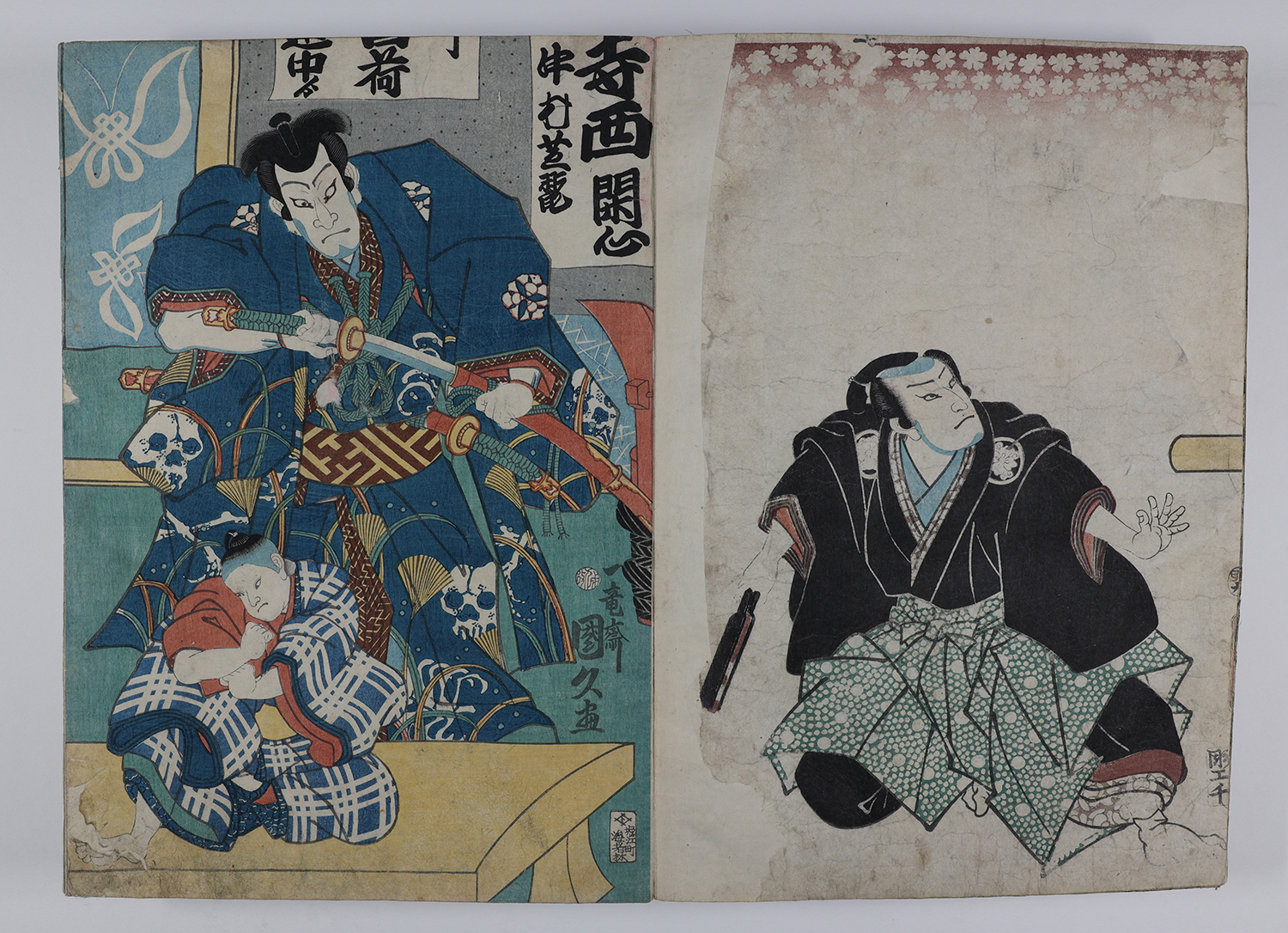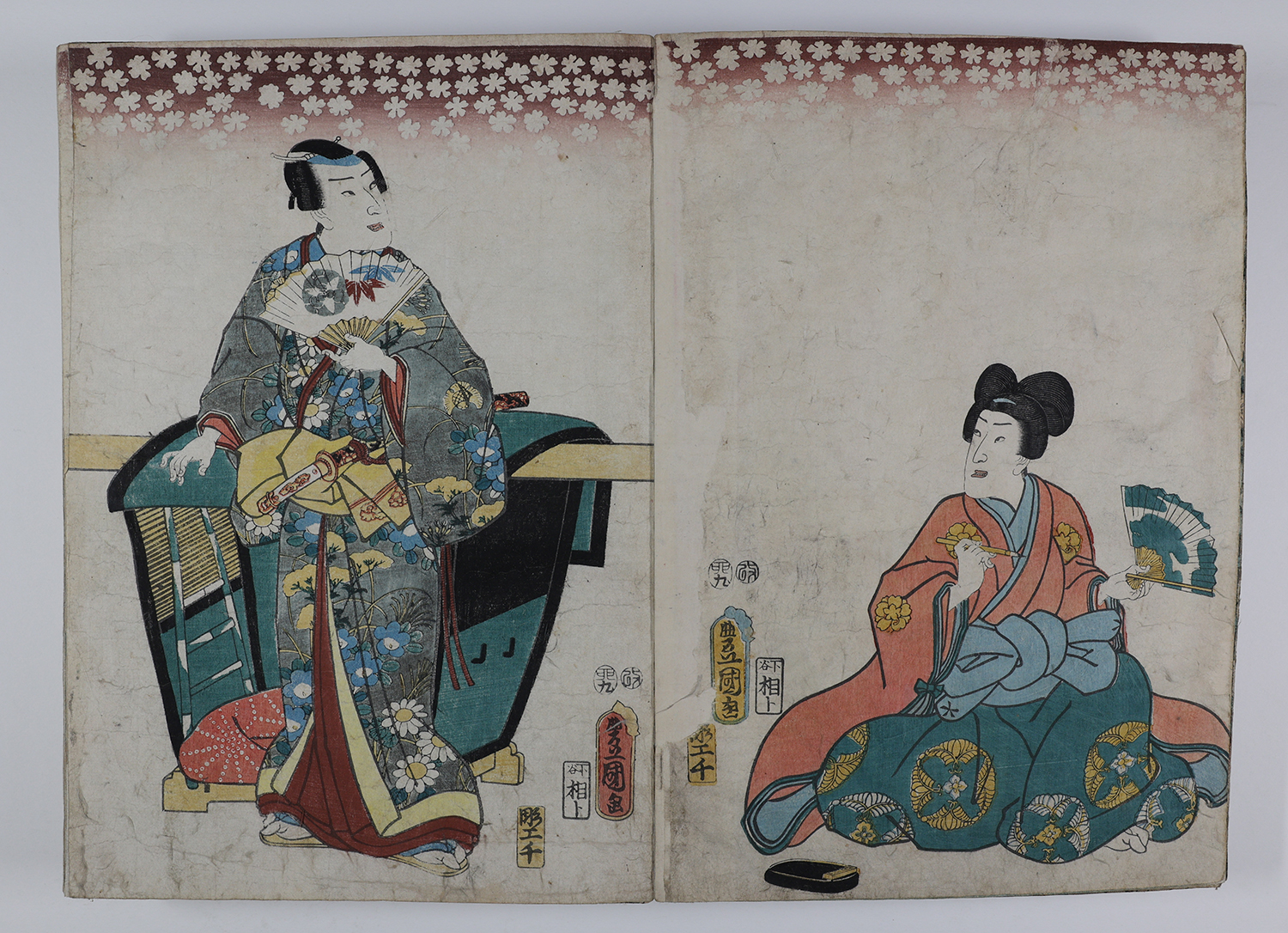Plates 08-10: Portraits of Three Kabuki Actors
Plates 08-10: Portraits of Three Kabuki Actors


Utagawa Kunisada 歌川 国貞 (Toyokuni III), 1786–1865
Portraits of Three Kabuki Actors (1855)
Ink and color on paper
Seals:
Publisher: Shitaya Aito
Sensor: Aratame 1855-IX
Block Cutter: Horiko Sen
Artist: Utagawa Toyokuni III
Utagawa Kunisada, also known as Toyokuni III, is one of the most prolific and commercially successful Japanese woodblock print artists, especially known for his kabuki portraits. This album contains many works by him. Kunisada was a pupil of Utagawa Toyokuni I 歌川豊国 (1769-1825) and trained in the Utagawa School 歌川派, one of the main schools of Ukiyo-e that was prominent from about 1770–1900. Prints from the Utagawa School typically feature complex, colorful designs, and kabuki portraits depicted the ‘true likenesses’ of actors which reflected the bold, stylized facial features of the actors in stage make-up. The actors in this spread are portrayed with animated expressions and wear colorful kimono decorated with highly detailed patterns. However, unlike a number of Kunisada’s later works that contain deeply colored or detailed landscape backgrounds, this spread is set on a comparatively simple white background.
The leftmost print of the triptych (plate 10) captures the figure in a very dramatic, dynamic position with his knees bent, his arm stiffly outstretched, and his hand flexed. This powerful pose, or mie 見得, would have been struck by the kabuki actor at the climactic moment of their character’s emotional peak. In the central print (plate 9), the actor stands with a fan in his hand and sword strapped to his waist, and the rightmost portrait (plate 8) shows the actor seated on the floor holding a fan and calligraphy pen. Although more understated than the leftmost print, the right and central prints are still expressive through emotive facial features and flowing folds of kimono. The three prints are visually united through the continuing floral motif atop each page as well as other portions of the compositions that extend across the panels. The bar of the palanquin in the central panel stretches into the left panel tying the prints together. However, it is not possible to discern if this feature continued onto the right panel because of a paper repair patch extending up the side of the page. Several portions of the prints have been patched, and fading damage is visible on the hands and feet of the actor in the leftmost print. It is also apparent that the prints were trimmed to fit in the album as seals and signatures on the bottom of the leftmost have partially been cut off.
Producing such finely detailed, multi-colored prints involved the collaboration of a number people, including the artist, woodblock carvers, engravers, printmakers, and publishers. To create the vibrant textiles in the actors’ kimono, several blocks would have been carved to print each different color. During the printmaking process, the various pigments would be layered to generate the polychrome final product. Artists could also add special effects to enhance the final print. One popular technique was bokashi, a gradation effect in the printmaking process. In this print, the artist employs bokashi 暈し in the floral motif across the top where the flowers’ forms are actually created out of the paper ground by printing a surrounding gradation background, causing the flowers to eventually blend into the background as the surrounding red pigment shifts from a darker to lighter hue.
Sophia Vogelsang
Chemistry & History of Art
Class of 2022
Annotated Bibliography:
Hartley, Craig, and Celia R. Withycombe. “Japanese Woodcuts from the Fitzwilliam Museum, Cambridge.” In Prints of the Floating World: Japanese Woodcuts from the Fitzwilliam Museum, Cambridge, 16–22. Cambridge: Fitzwilliam Museum, 1997.
The article discusses the production process and materials used in making Japanese woodblock prints. In particular, the author describes special effects added to prints during final production, including bokashi, a technique used to create gradation, which can be seen in the floral motif on this spread of prints.
Schaap, Robert, and Sebastian Izzard, and Kunisada Utagawa. “Utagawa Kunisada, the Artist and His Times.” Essay. In Kunisada: Imaging Drama and Beauty, 9–35. Leiden, Netherlands: Hotei Publishing, 2016.
This introduction discusses the historical context of Kunisada’s lifetime and examines his prints thematically and chronologically from his early to late career. The author provides useful information about the start of Kunisada’s career and apprenticeship to Toyokuni. A number of actor prints are considered as well as Kunisada’s relationship with Kabuki theater culture and actors.
Tinios, Ellis. “Kunisada and the Last Flowering of ‘Ukiyo-e’ Prints.” Print Quarterly, 8 (4), (1991): 342–362.
This article focuses on the late works of Kunisada from the last two decades of his career, which is the period during which he made this spread of Kabuki actor prints in 1855. During this time, Kunisada was very well-known and in high demand, and he produced a large number of prints with the help of a number of assistants. In later prints, the designs shift towards more complexity and included colorful backgrounds, some with very detailed landscapes (which is interesting since this spread has simple white background.
Tinios, Ellis. Mirror of the stage: The actor prints of Kunisada. University Gallery Leeds, 1996.
The book considers the woodblock prints of Utagawa Kunisada with a focus on his actor prints. This includes detailed discussions of the intertwined relationship of woodblock prints and Kabuki theater culture, the commercial production of prints, and Kunisada’s career as an artist which help contextualize this spread of actor portraits.
